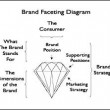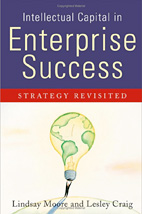Many food products are quietly removing the word “natural” from their labels amid a wave of lawsuits that have arisen to challenge the “naturalness” of many venerable natural food and beverage products within the $40 billion natural foods industry.
Brand Strategy
"Brand strategy" involves all the strategic documents that are used in the creation, development and management of a brand for an enterprise, a product, a service, or an idea. Brand strategy involves identifying what a brand will stand for, the position it will own in the marketplace, its architecture, and the marketing strategy that will be used to build it.
Intangible assets, intellectual capital or property? It does make a difference
In modern discussions regarding the value of intellectual property, terminology can often become confusing. To prevent misunderstanding, it’s important to differentiate between “intangible assets,” “intellectual capital” and “intellectual property.”
Branding Diamonds
During the 1990s, De Beers Consolidated Mines began the then seemingly unusual practice of “Branding” its diamonds. It began inscribing a small Brand Mark on its stones to differentiate its products within the commodity marketplace, and to ensure their worth against the inexorable declining value of non-oil commodities. The growing success of Brands, Branding and the strategies of Consumer Packaged Goods (CPG) Marketing are widely recognized within the global business community.
The Strategic Significance of Brands
Achieving brand relevance is a strategic task that, by its very nature, is never complete in the volatile markets of our rapidly changing societies. Each and every day more brands enter the marketplace. Ironically, as their numbers increase, there are fewer and fewer brands that really stand for anything significant in the minds of the public.
Brand equity critical in firms’ valuation (PDF)
With the dawn of the Age of Intellectual Capital, during the mid ’90s, came the realization that the real wealth in the modern enterprise is located in the intangible assets of that enterprise—as opposed to the “traditional (tangible) assets” such as real estate, plant, equipment, inventory, cash and the like.
The State as a Brand
Brand gurus have long declared that all public entities and identities, and not just consumer packaged goods, are “Brands.” Today we see the truth of that assertion as we recognize the emergence of the “Brand-State.”
Branding Radioactive Waste
One of the biggest problems in branding is branding across cultures and on a global basis. However, even such a difficult undertaking as global branding is dwarfed by the magnitude of branding radioactive waste, not only across global cultures, but thousands of years into the future.
Branding Commodity Products
Producers of raw materials and commodity products often overlook the opportunity to increase their gross margins, create consumer demand for their specific items(s), and build valuable Brand Equity by employing the branding practices made successful by consumer packaged goods enterprises.
Brand Faceting and Marketing Strategy
Managing the growth and change of a Brand has always been difficult, requiring both art and wisdom. Most Brands are either over-managed and not allowed to change, or not managed at all and allowed to drift or even languish without strategic guidance or direction. The real art is to manage your Brand in such a way as to respect its natural expression. There is an art to it.




 As the knowledge-based economy expands, the companies and individuals that possess intangible intellectual assets, such as intellectual property, will need specialized expertise, strategic thinking, legal experience, and the wisdom necessary to manage intellectual assets.
As the knowledge-based economy expands, the companies and individuals that possess intangible intellectual assets, such as intellectual property, will need specialized expertise, strategic thinking, legal experience, and the wisdom necessary to manage intellectual assets.